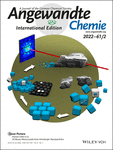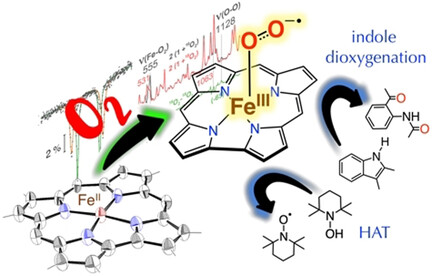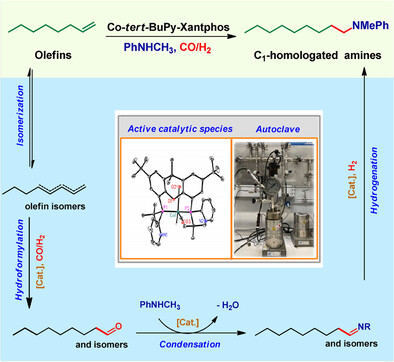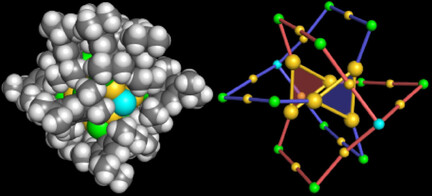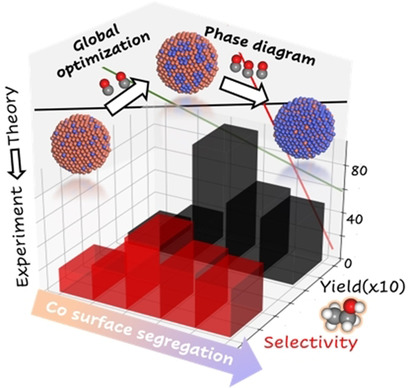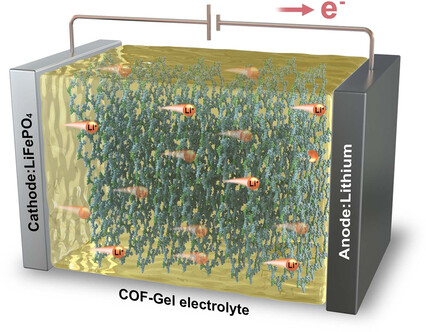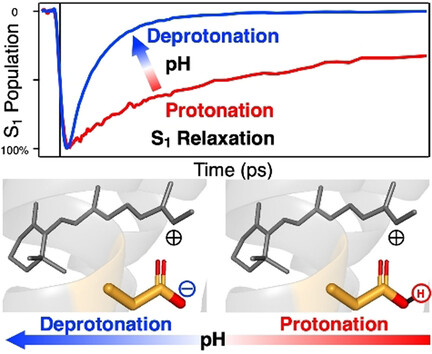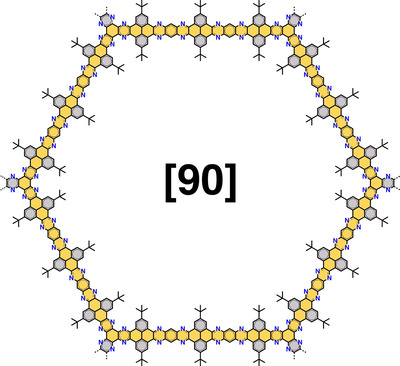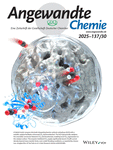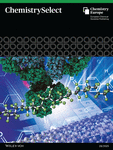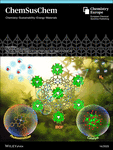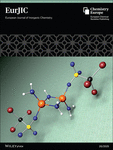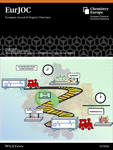Journal list menu
Export Citations
Download PDFs
Cover Pictures
Cover Picture: 3D Binary Mesocrystals from Anisotropic Nanoparticles (Angew. Chem. Int. Ed. 2/2022)
- First Published: 06 December 2021
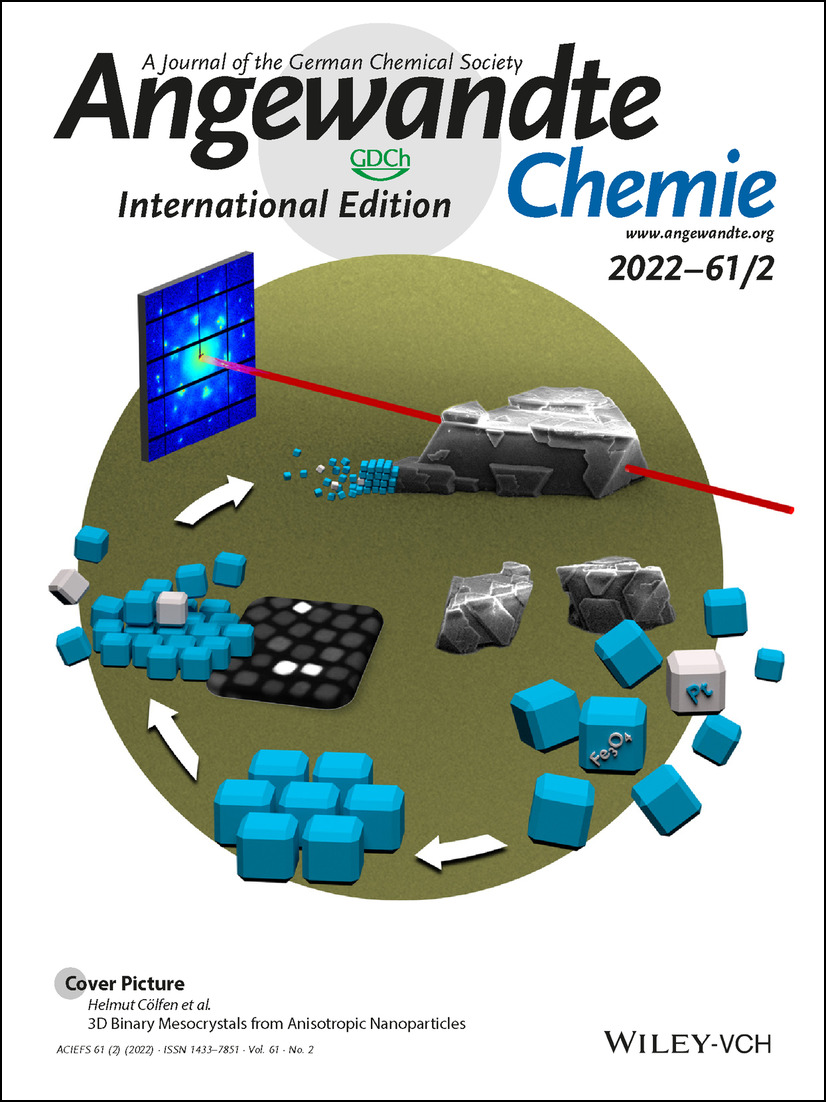
Binary mesocrystals demonstrate the combination of nanocrystals from different materials within a highly ordered manner. While nanocubes appear to be simple in their geometry, they can arrange in various ways into a complex entity that not only directs its habitus but also its properties. In their Research Article (e202112461), Helmut Cölfen et al. report on the formation and structural analysis of micrometer-sized two- and three-dimensional binary particle assemblies, revealing their mesocrystalline nature and highlighting their importance within the growing field of metamaterials.
Inside Cover: Reactivities of Interstitial Hydrides in a Cu11 Template: En Route to Bimetallic Clusters (Angew. Chem. Int. Ed. 2/2022)
- First Published: 13 December 2021

Depending on the nature of M+ , the hydrides of the H2Cu11 reactant behave differently. In the case of M=Cu or Ag, they act as regular two-electron ligands yielding [CuH2Cu11{S2P(OiPr)2}6(C≡CPh)3]+ (Cu12H2) or [AgH2Cu14{S2P(OiPr)2}6(C≡CPh)6]+ (AgH2Cu14); in the case of M=Au, they behave as electron donors to form [AuCu11{S2P(OiPr)2}6(C≡CPh)3Cl] (AuCu11). Details of the study are presented by Jean-Yves Saillard, Chen-Wei Liu, and co-workers in their Research Article (e202113266).
Inside Back Cover: Correlating Reaction Dynamics and Size Change during the Photomechanical Transformation of 9-Methylanthracene Single Crystals (Angew. Chem. Int. Ed. 2/2022)
- First Published: 06 December 2021
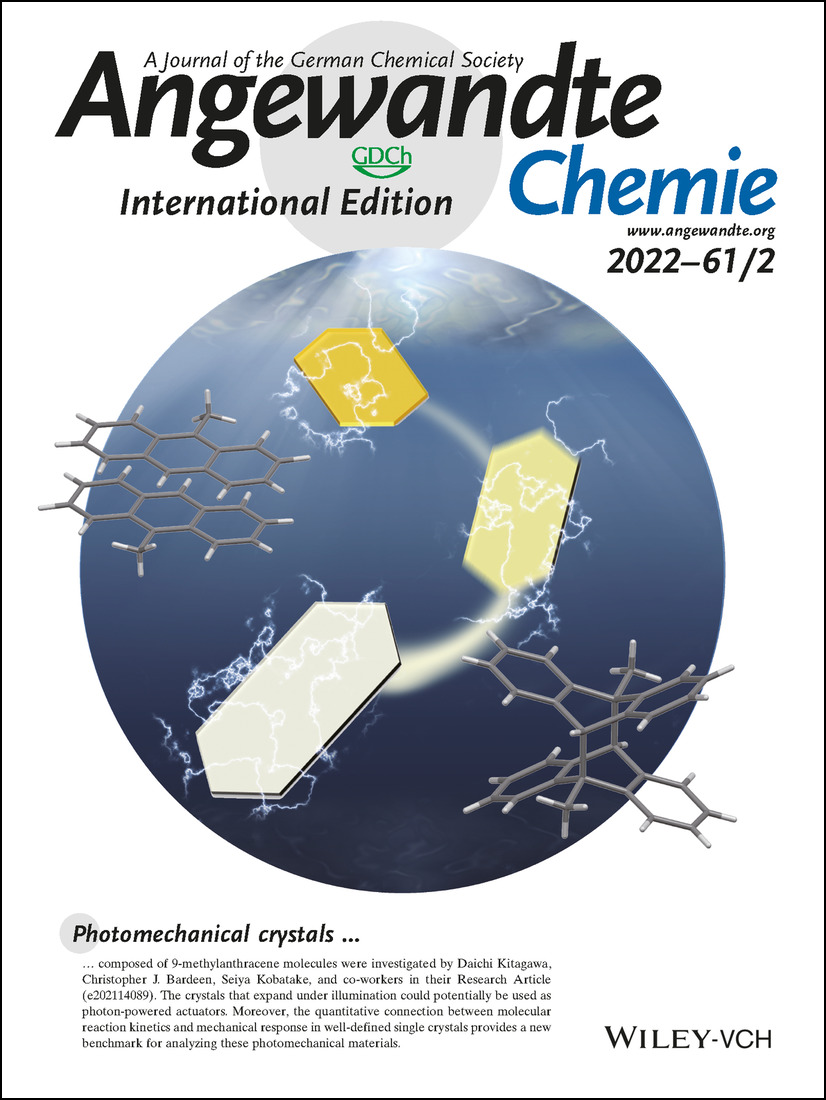
Photomechanical crystals composed of 9-methylanthracene molecules were investigated by Daichi Kitagawa, Christopher J. Bardeen, Seiya Kobatake, and co-workers in their Research Article (e202114089). The crystals that expand under illumination could potentially be used as photon-powered actuators. Moreover, the quantitative connection between molecular reaction kinetics and mechanical response in well-defined single crystals provides a new benchmark for analyzing these photomechanical materials.
Back Cover: Ring-Opening Metathesis Polymerization of a Macrobicyclic Olefin Bearing a Sacrificial Silyloxide Bridge (Angew. Chem. Int. Ed. 2/2022)
- First Published: 13 December 2021

A sequence-controlled ring-opening metathesis polymerization strategy based on macrobicyclic olefins bearing a sacrificial silyloxide bridge was developed by Hong Yang and co-workers as described in their Communication (e202112526). The cover image depicts a “magic” production line of sequence-defined polymers. The monomeric sequence information shown as a colored ball chain is implanted in the macro-ring, while the small ring induces narrow polydispersity and high regio- and stereospecificity.
Frontispiece
Frontispiece: Near-Equilibrium Growth of Chemically Stable Covalent Organic Framework/Graphene Oxide Hybrid Materials for the Hydrogen Evolution Reaction
- First Published: 04 January 2022
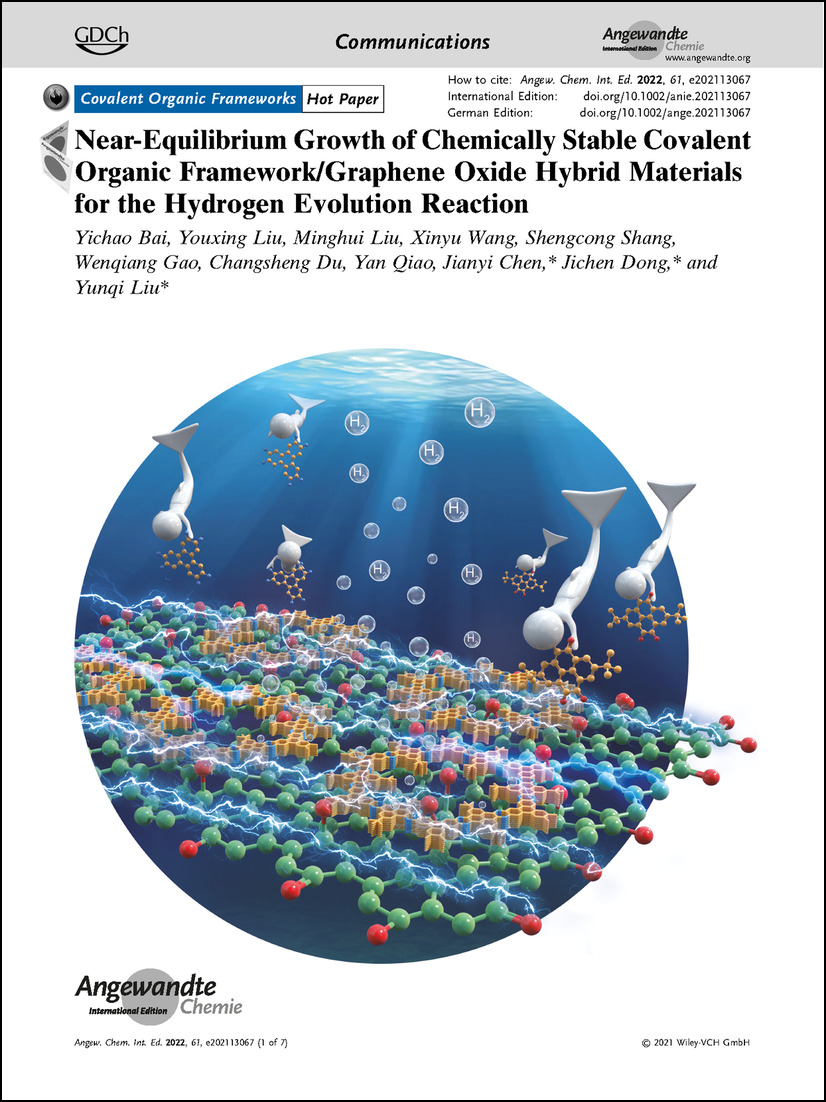
Covalent Organic Frameworks Near-equilibrium growth of chemically stable covalent organic framework–graphene oxide hybrid materials for the hydrogen evolution reaction is reported in the Communication by Jianyi Chen, Jichen Dong, Yunqi Liu et al. (e202113067).
Frontispiece: Detection and Imaging of the Plant Pathogen Response by Near-Infrared Fluorescent Polyphenol Sensors
- First Published: 04 January 2022
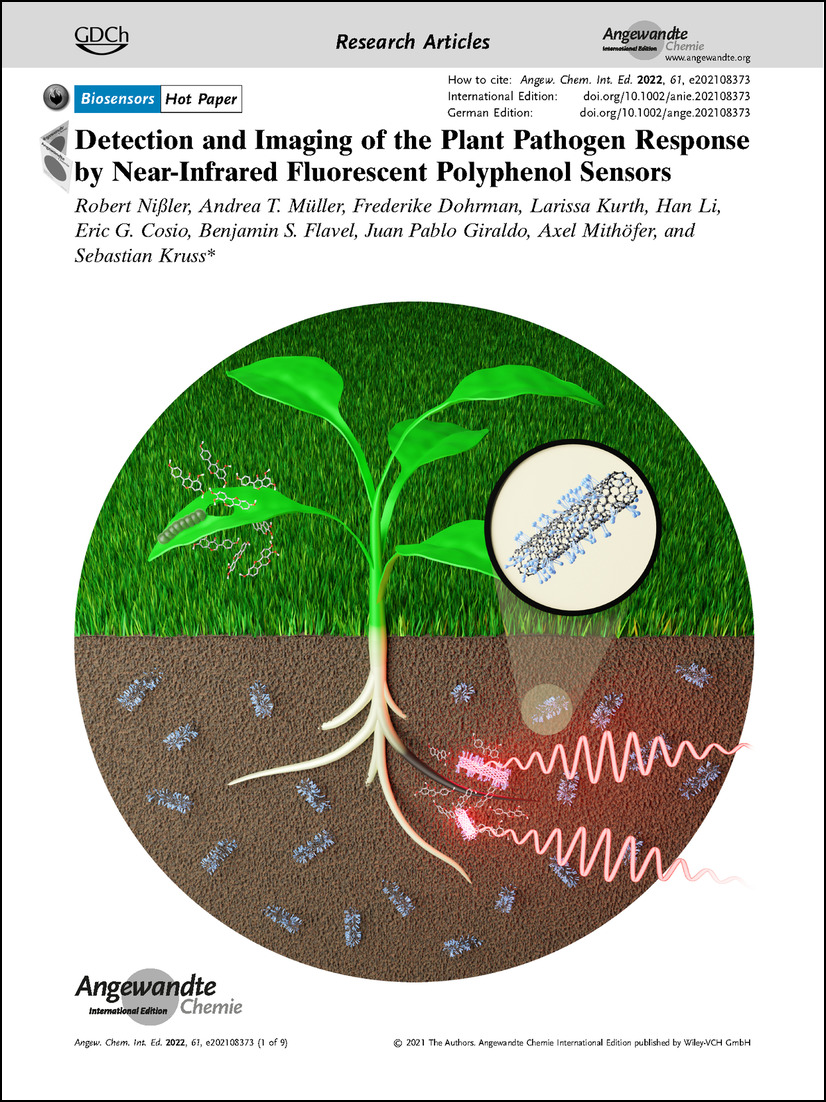
Biosensors Molecular sensors for plant polyphenol imaging based on near-infrared fluorescent single wall carbon nanotubes are presented by Sebastian Kruss et al. in their Research Article (e202108373).
Graphical Abstract
Corrigendum
Corrigendum: Reactions of a Dilithiomethane with CO and N2O: An Avenue to an Anionic Ketene and a Hexafunctionalized Benzene
- First Published: 04 January 2022
Corrigendum: Total Syntheses of Sarcandrolide J and Shizukaol D: Lindenane Sesquiterpenoid [4+2] Dimers
- First Published: 04 January 2022
Corrigendum: An Artificial Phase-Transitional Underwater Bioglue with Robust and Switchable Adhesion Performance
- First Published: 04 January 2022
Introducing …
Reviews
Methane Conversion
Photocatalytic Conversion of Methane: Recent Advancements and Prospects
- First Published: 26 July 2021
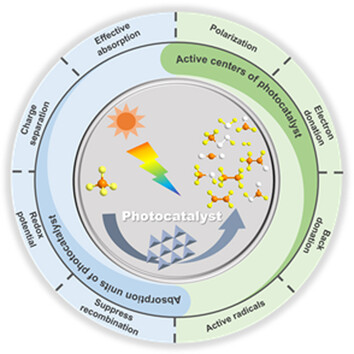
The conversion of methane driven by solar energy offers a promising approach to directly transform methane into valuable energy sources under mild conditions, but remains a great challenge. This Review highlights recent advances in the photocatalytic conversion of methane and gives insights into the design of effective semiconductor-based photocatalysts and classifies the photooxidations according to the oxidants in the reaction system.
Copper Sulfides
Crystal Structure Classification of Copper-Based Sulfides as a Tool for the Design of Inorganic Functional Materials
- First Published: 09 August 2021

A classification of copper sulfides based on crystallographic features has been proposed from investigation of the structure–property relationships reported on their phases in dozens of publications from the fields of crystallography and materials for energy conversion. This classification reveals systematic trends that can be explained and exploited for the design and engineering of new environmentally friendly materials.
Communications
Covalent Organic Frameworks | Hot Paper
Near-Equilibrium Growth of Chemically Stable Covalent Organic Framework/Graphene Oxide Hybrid Materials for the Hydrogen Evolution Reaction
- First Published: 26 October 2021
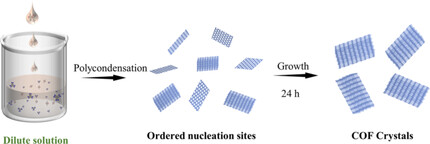
A liquid-phase method has been developed for the synthesis of highly conjugated covalent organic frameworks (COFs). Vacuum filtration leads to the formation of a uniform conducting film of the COFs and COF-GO hybrid materials on a variety of substrates. The overpotential of one of the materials was as low as 45 mV in 0.5 m H2SO4 and reached a current density of 10 mA cm−2, which is better than all the metal-free catalysts currently available.
Post-Translational Modifications
Site-Selective Installation of Nϵ-Modified Sidechains into Peptide and Protein Scaffolds via Visible-Light-Mediated Desulfurative C–C Bond Formation
- First Published: 29 October 2021

We describe a rapid light-activated C(sp3)–C(sp3) bond-forming reaction that enables installation of Nϵ-modified sidechains into peptides and proteins at defined positions. Selective for cysteine residues, the method proceeds via interception of free-radical-mediated desulfurization. The chemistry is operationally simple, tolerant to ambient atmosphere, and retains the native stereochemistry at the modified residue.
Supramolecular Chemistry
Photo-Induced Polymer Cyclization via Supramolecular Confinement of Cyanostilbenes
- First Published: 29 October 2021
Oxygen Reduction Reaction
Tailoring the Electronic Structure of an Atomically Dispersed Zinc Electrocatalyst: Coordination Environment Regulation for High Selectivity Oxygen Reduction
- First Published: 29 October 2021

A flexible alteration of an 2 e−/4 e− oxygen reduction reaction (ORR) pathway was discovered by tuning the coordination environment of Zn single sites derived from MOF-5 by varying the functional group of ligands within the metal–organic framework (MOF) precursors. The formed ZnN4 follows a 4 e− ORR pathway, while ZnO3C achieves a maximum H2O2 production rate of 340 mmol g−1 h−1.
Dioxygen Activation | Hot Paper
Systems Chemistry
Emergence of a Promiscuous Peroxidase Under Non-Equilibrium Conditions
- First Published: 12 November 2021
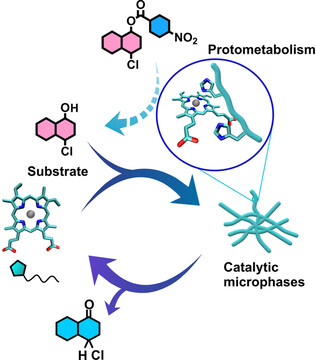
Substrate-induced generation of a transient catalytic microphase was shown in presence of a single amino acid functionalized fatty acid and a cofactor hemin. The transient state exhibited acceleration of catalytic potential resulting in degradation of the substrate. Furthermore, latent catalytic function was displayed to hydrolyze a precursor to yield the same substrate suggesting promiscuous activity.
Polymers | Hot Paper
Ring-Opening Metathesis Polymerization of a Macrobicyclic Olefin Bearing a Sacrificial Silyloxide Bridge
- First Published: 24 October 2021

We developed a macrobicyclic olefin system bearing a sacrificial silyloxide bridge on the α,β′-positions of the double bond as a new sequence-defined monomer for regio-selective ring-opening metathesis polymerization. The monomeric sequence information is implanted in the macro-ring, while the small ring with a substantial ring tension can provide not only narrow polydispersity, but also high regio-/stereospecificity.
Catalysis | Very Important Paper
A Selective and General Cobalt-Catalyzed Hydroaminomethylation of Olefins to Amines
- First Published: 05 November 2021
Nitrogen Fixation | Hot Paper
Rhenium-Mediated Conversion of Dinitrogen and Nitric Oxide to Nitrous Oxide
- First Published: 29 October 2021
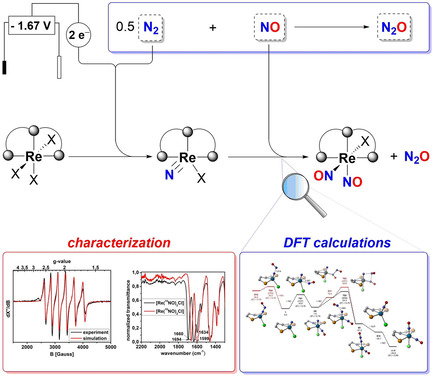
The coupling of (electro-)chemically driven, reductive N2 splitting with nitrogen atom transfer to NO is reported. Nitrous oxide generation directly from dinitrogen and nitric oxide defines a new strategy for direct oxidative nitrogen fixation. Initial coordination of an activating NO ligand prepares the chemically robust ReV nitride for Re≡N/NO radical coupling.
Water Splitting | Hot Paper
Fully Condensed Poly (Triazine Imide) Crystals: Extended π-Conjugation and Structural Defects for Overall Water Splitting
- First Published: 08 November 2021
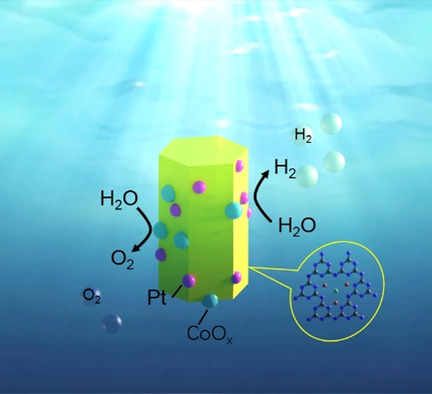
A fully condensed poly (triazine imide) crystal, which features extended π-conjugation and deficient structural defects, decorated with Pt and CoOx as redox cocatalysts efficiently drives the one-step excitation overall water splitting for H2 and O2 production with a record apparent quantum efficiency of 12 % at 365 nm.
Gold Clusters | Hot Paper
A Face-to-Face Dimer of Au3 Superatoms Supported by Interlocked Tridentate Scaffolds Formed in Au18S2(SR)12
- First Published: 09 November 2021
Battery Materials | Hot Paper
Atomistic Insights of Irreversible Li+ Intercalation in MnO2 Electrode
- First Published: 26 October 2021
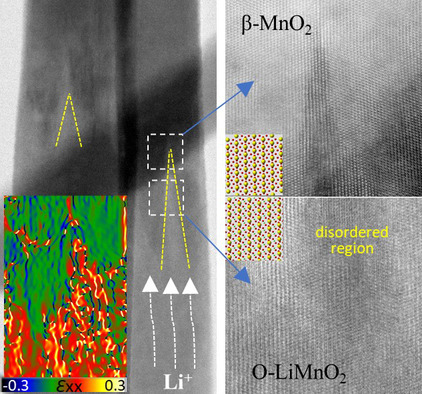
The lithiation front region of one β-MnO2 nanowire analyzed by in situ TEM, where the MnO2/LiMnO2 interface features arrow-headed disordered regions, is disclosed with its atomic structure clearly captured. The findings have a bearing on MnO2 open-framed electrode materials for reversible energy storage.
Photocatalysis
Leveraging the n→π* Interaction in Alkene Isomerization by Selective Energy Transfer Catalysis
- First Published: 08 November 2021

Fumarate to maleate (E→Z) isomerization was investigated to validate nO→ πC=O* interactions as a driving force for contra-thermodynamic isomerization. A general protocol based on selective energy transfer catalysis was developed with inexpensive thioxanthone as a sensitizer for the conversion of diverse fumarate derivatives, including tetrasubstituted alkenes. The involvement of nO→πC=O* interactions was confirmed by X-ray crystallography.
Drug Delivery
Virus-Mimicking Cell Membrane-Coated Nanoparticles for Cytosolic Delivery of mRNA
- First Published: 25 October 2021
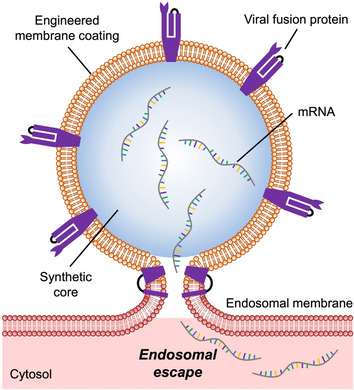
Cell membrane-coated nanoparticles are engineered to express a viral fusion protein, thus enabling them to exhibit improved endosomal escape properties. It is demonstrated that these virus-mimicking nanocarriers are able to deliver mRNA payloads to the cytosolic compartment after cellular uptake, enhancing expression of the encoded proteins both in vitro and in vivo.
Biocatalysis
Engineering a Non-Natural Photoenzyme for Improved Photon Efficiency
- First Published: 05 November 2021

We developed a novel HTS engineering platform to optimize photoenzymatic activity. The improvements in variants were correlated to an increase in enzymatic photon efficiency. Transient absorption spectroscopy revealed a shift from a stepwise to a concerted mechanism. The platform was expanded to improve the synthesis of γ, δ, ϵ-lactams, and acyclic amides.
Photochemistry
Dynamic Manipulating Space-Resolved Persistent Luminescence in Core–Shell MOFs Heterostructures via Reversible Photochromism
- First Published: 07 November 2021
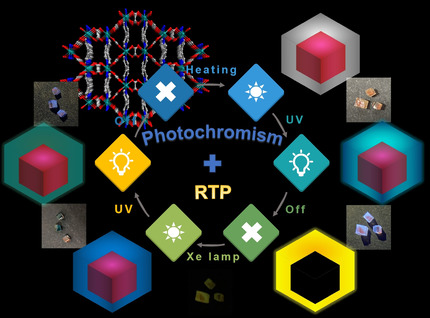
Multiblock core–shell MOFs heterojunctions were prepared through an epitaxial growth process, in which the shell exhibits both persistent luminescence and photochromic properties. The bright yellow afterglow in MOFs shell can be detected before irradiation but almost disappears after coloration upon continuous UV irradiation.
Foldamers | Very Important Paper
Folding-induced Fluorescence Enhancement in a Series of Merocyanine Hetero-Folda-Trimers
- First Published: 16 November 2021
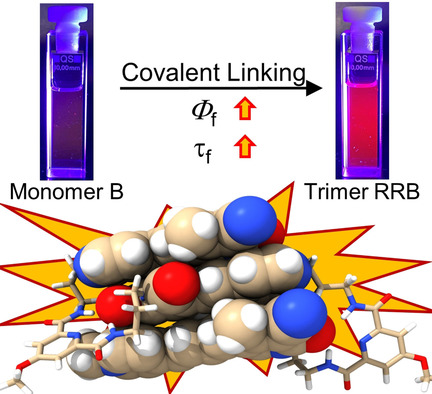
Pronounced fluorescence enhancement could be shown for a weakly fluorescent merocyanine dye in hetero-folda-trimer architectures. This folding-induced fluorescence enhancement (FIFE) for specific sequences of π-stacked dyes points at a viable strategy towards improved fluorophores that relates to the approach used by nature in the green fluorescent protein (GFP).
Research Articles
Biosensors | Hot Paper
Detection and Imaging of the Plant Pathogen Response by Near-Infrared Fluorescent Polyphenol Sensors
- First Published: 05 October 2021
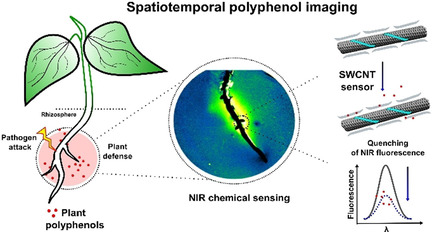
Molecular sensors for plant polyphenol imaging based on near-infrared (NIR) fluorescent single-wall carbon nanotubes (SWCNTs) are presented. These sensors probe the polyphenol content in complex biological systems such as the plant rhizosphere. In summary, this approach enables real-time spatiotemporal visualization of plant defense via polyphenols release.
Self-Assembly | Hot Paper
3D Binary Mesocrystals from Anisotropic Nanoparticles
- First Published: 20 October 2021

The self-assembly of anisotropic nanoparticles into large superstructures is a key component in the research of novel metamaterials. While the formation of mono-phase mesocrystals has been achieved in recent years, the self-assembly of binary structures from such particles remained highly challenging. A simple method enables the formation of binary mesocrystals from anisotropic iron oxide and platinum nanocubes in two and three dimensions.
CO2 Hydrogenation
Moderate Surface Segregation Promotes Selective Ethanol Production in CO2 Hydrogenation Reaction over CoCu Catalysts
- First Published: 22 October 2021
Alzheimer's Disease
NIR-II Hydrogen-Bonded Organic Frameworks (HOFs) Used for Target-Specific Amyloid-β Photooxygenation in an Alzheimer's Disease Model
- First Published: 04 November 2021
Drug Discovery | Hot Paper
Discovery and Mechanism of Action of Small Molecule Inhibitors of Ceramidases
- First Published: 20 October 2021

Use of synthetic fluorescent ceramide molecules allows the discovery of the first selective drug-like small molecule inhibitors for alkaline ceramidase 3, an intra-membrane enzyme involved in sphingolipid metabolism in health and disease. These inhibitors represent a new paradigm for controlling lipid metabolism with drug-like small molecules targeting conformationally dynamic membrane proteins.
Nonlinear Optical Switches | Hot Paper
An Exceptional Thermally Induced Four-State Nonlinear Optical Switch Arising from Stepwise Molecular Dynamic Changes in a New Hybrid Salt
- First Published: 15 October 2021
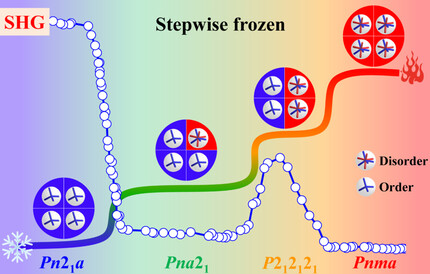
A new simple hybrid salt has been synthesized that exhibits reversible multistep phase transitions and an unprecedented thermally induced three-step “silent-medium-low-high” second-harmonic-generation switching behavior. This behavior arises from complex and stepwise molecular dynamic changes of the polar organic cations.
Silicon Chemistry | Hot Paper
A Striking Mode of Activation of Carbon Disulfide with a Cooperative Bis(silylene)
- First Published: 20 October 2021
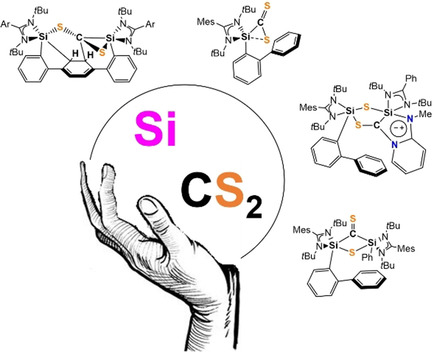
An unexpected new type of cooperativity of the two silicon(II) atoms in a 1,4-terphenyl-bridged bis(silylene) towards CS2 is reported and the results are compared with that of related mono-silylenes. While a dearomatization occurs with the bis-silylene, a novel mesoionic five-membered Si2S2C heterocyclic compound, among other new products, results from stepwise degradation of CS2 with mono-silylenes.
Battery Materials
Highly Processable Covalent Organic Framework Gel Electrolyte Enabled by Side-Chain Engineering for Lithium-Ion Batteries
- First Published: 28 October 2021
CO Reduction
C−C Coupling Is Unlikely to Be the Rate-Determining Step in the Formation of C2+ Products in the Copper-Catalyzed Electrochemical Reduction of CO
- First Published: 15 November 2021
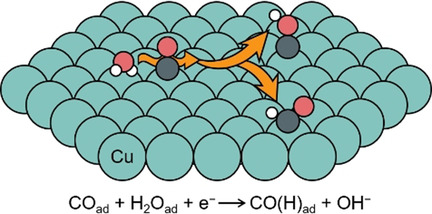
Electrokinetic and surface-enhanced infrared spectroscopic results indicate that the C−C coupling is unlikely to be the rate-determining step (RDS) in the formation of C2+ products in the electrochemical CO reduction reaction. Electrochemical hydrogenation of CO with adsorbed water as the proton donor is proposed as the RDS.
Strained Molecules | Hot Paper
Electrophilic Activation of [1.1.1]Propellane for the Synthesis of Nitrogen-Substituted Bicyclo[1.1.1]pentanes
- First Published: 27 October 2021
![Electrophilic Activation of [1.1.1]Propellane for the Synthesis of Nitrogen-Substituted Bicyclo[1.1.1]pentanes](/cms/asset/84719249-0f0c-49ee-815f-bf03d372b633/anie202111291-toc-0001-m.jpg)
The third way: the umpolung of nucleophilic [1.1.1]propellane into an electrophilic halogen bond complex enables the synthesis of nitrogen-substituted bicyclo[1.1.1]pentanes (BCP) after attack of anilines and azoles. DFT calculations show that the halogen bond interaction helps avoiding the decomposition of the BCP cage. This approach opens a third avenue to access functionalised BCPs besides the better explored radical and anionic strategies.
CO2 Reduction Reaction | Hot Paper
Highly Ethylene-Selective Electrocatalytic CO2 Reduction Enabled by Isolated Cu−S Motifs in Metal–Organic Framework Based Precatalysts
- First Published: 23 October 2021
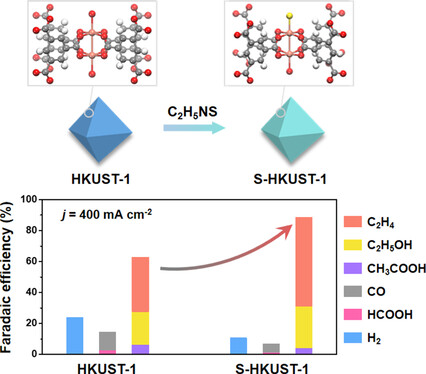
A S-HKUST-1 precatalyst with stable isolated Cu−S motifs was prepared by the strategy of local sulfur doping. The precatalyst can be in situ reconstructed to obtain a Cu(S) matrix with active biphasic copper/copper sulfide interfaces, which delivers a current density of 400 mA cm−2 with Faradaic efficiency of ethylene to 57.2 % in the flow cell.
Nanocontainers
Transport of Molecular Cargo by Interaction with Virus-Like Particle RNA
- First Published: 30 October 2021

The binding of intercalating dyes such as thiazole orange (TO) to polynucleotides allows for a simple method to load RNA-rich virus-like particles with molecular cargo, and then to release that cargo by diffusion. TO-labeled molecules come out much slower than they go in because of the high RNA concentration inside the shell; the surprise is how much cargo these easily produced nanocontainers can carry.
Battery Materials | Hot Paper
Vacancy Modulating Co3Sn2S2 Topological Semimetal for Aqueous Zinc-Ion Batteries
- First Published: 15 October 2021

A Weyl semimetal Co3Sn2S2 cathode was applied in aqueous Zn-ion batteries with a discharge plateau around 1.5 V. Co3Sn1.8S2 activates Sn2+ and provides active sites with impressive charge-storage capabilities and fast kinetic processes. The material has high structural stability and conductivity, and an ionic diffusion rate that achieves appreciable cycling stability and capacity retention.
Biophysics | Hot Paper
A Unified View on Varied Ultrafast Dynamics of the Primary Process in Microbial Rhodopsins
- First Published: 20 October 2021
Proton Transport | Hot Paper
Dynamic Optical Visualization of Proton Transport Pathways at Water–Solid Interfaces
- First Published: 09 November 2021
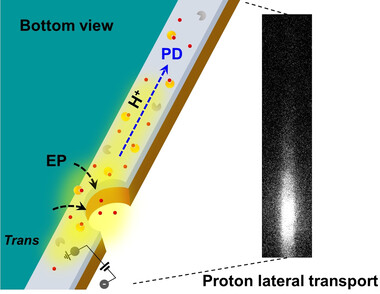
We developed a method for imaging aqueous proton transport with spatial resolution and observed the lateral transport of protons along the nanofluidic interface. The dynamics of proton transport can be further captured by quantitative analysis, thanks to the temporal resolution of this optical imaging technique.
Nanozymes
Cascaded Nanozyme System with High Reaction Selectivity by Substrate Screening and Channeling in a Microfluidic Device
- First Published: 08 November 2021

The reaction selectivity of a nanozyme system was enhanced by screening and channeling of substrates. A catalytic cascade incorporating N-doped carbon nanocages with oxidase-like activity, and Prussian blue nanoparticles with peroxidase-like activity, improved reaction selectivity by more than 2000 times.
Supramolecular Chemistry | Hot Paper
Clippane: A Mechanically Interlocked Molecule (MIM) Based on Molecular Tweezers
- First Published: 11 October 2021
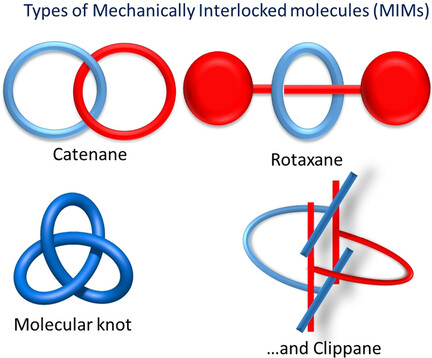
We present a new type of MIM comprised by two “open” U-shaped metallotweezers. The dissociation into its two components is hampered by mechanical bonds, as the presence of bulky tert-butyl groups provides the mechanical coercion required for avoiding the slippage that would otherwise produce the disassembly.
Heterogeneous Catalysis
Zr(OH)4-Catalyzed Controllable Selective Oxidation of Anilines to Azoxybenzenes, Azobenzenes and Nitrosobenzenes
- First Published: 13 October 2021
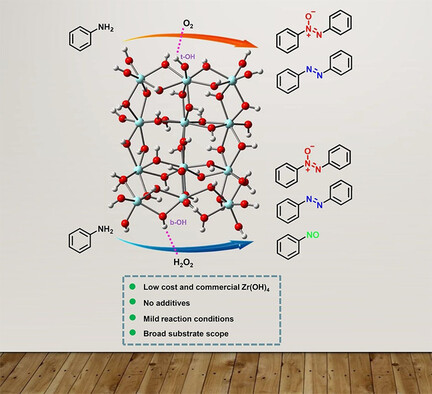
Zr(OH)4 can catalyze the selective oxidation of anilines to azoxybenzenes, symmetric/unsymmetric azobenzenes and nitrosobenzenes for a wide range of substrates. Control experiments and DFT calculations reveal that the activation of H2O2 and O2 can be attributed to the bridging hydroxyl and terminal hydroxyl groups of Zr(OH)4, respectively.
Imaging Agents | Hot Paper
Labile Photo-Induced Free Radical in α-Ketoglutaric Acid: a Universal Endogenous Polarizing Agent for In Vivo Hyperpolarized 13C Magnetic Resonance
- First Published: 22 October 2021

α-Ketoglutaric acid (α-KG) has an exceptionally high free radical yield under photo-irradiation at cryogenic temperature. This radical can be used as a universal polarizing agent to hyperpolarize 13C-molecules such as [1-13C]lactate, a promising alternative to pyruvate for in vivo metabolic studies by 13C magnetic resonance.
Electrocatalysis
Dual Nanoislands on Ni/C Hybrid Nanosheet Activate Superior Hydrazine Oxidation-Assisted High-Efficiency H2 Production
- First Published: 20 October 2021
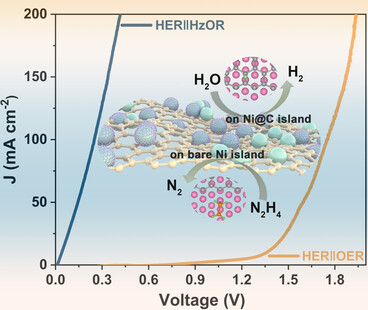
A Ni/C hybrid nanosheet array with dual-active nanoisland sites is reported. One type of island represents the bare Ni particle surface, the other consists of core–shell Ni@C structures (denoted as Ni-C HNSA). The catalyst achieves efficient hydrogen production in an overall hydrazine splitting, showing its potential for practical applications.
Solid-State Batteries | Hot Paper
Eutectic Crystallization Activates Solid-State Zinc-Ion Conduction
- First Published: 19 October 2021
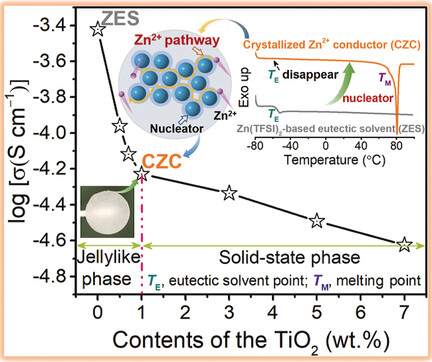
Here, we discovered a novel crystallized Zn2+ conductor based on inducing crystallization of high-entropy, charge-separated eutectic liquids. To the best of our knowledge, it is the first introduction of the concept of a crystallized eutectic material to achieve dramatically enhanced multivalent-ion transport properties. This facile strategy may also open up opportunities for designing a wide variety of new solid ionic conductors.
Organic Electronics | Hot Paper
Sterically Wrapped Multiple Resonance Fluorophors for Suppression of Concentration Quenching and Spectrum Broadening
- First Published: 11 October 2021
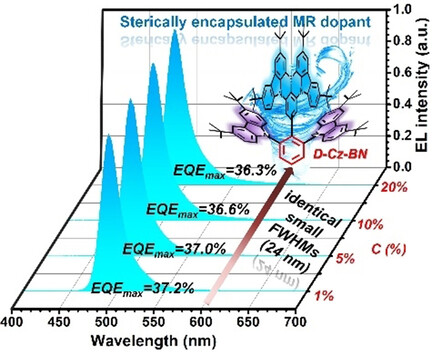
Sterically wrapped multiple resonance (MR) dopants with the MR-core sandwiched by bulk substituents have been developed to suppress molecular interactions, realizing organic light-emitting diodes with remarkably high maximum external quantum efficiencies of 36.3–37.2 %, identical small FWHMs of 24 nm and alleviated efficiency roll-offs over a wide range of dopant concentrations (1–20 wt %).
Cluster Compounds | Very Important Paper
Reactivities of Interstitial Hydrides in a Cu11 Template: En Route to Bimetallic Clusters
- First Published: 09 November 2021
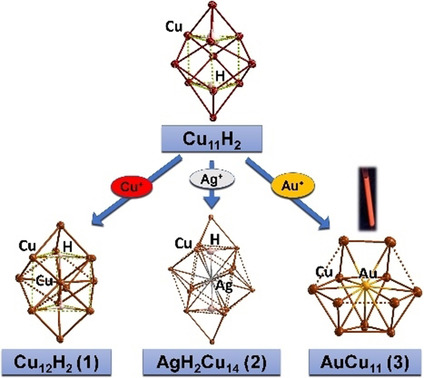
While the reaction of the [Cu11H2{S2P(OiPr)2}6(C≡CPh)3] template with Cu+ or Ag+ produces Cu12H2 and AgCu14H2 species in which the hydrides behave as Lewis bases, in the reaction with Au+, the hydrides act as reducing agents, leading to a luminescent, two-electron Au@Cu11 superatom, whose metal core has a defect fcc structure.
Covalent Organic Frameworks | Hot Paper
Two-Dimensional Fluorinated Covalent Organic Frameworks with Tunable Hydrophobicity for Ultrafast Oil–Water Separation
- First Published: 28 October 2021
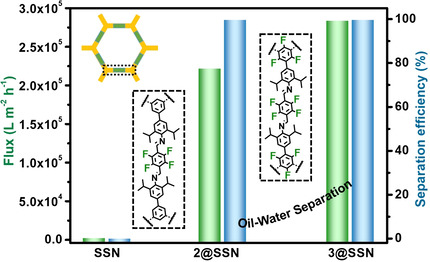
Three 2D robust COFs with controllable hydrophobicity and processability were synthesized by introducing mixed hydrophobic substituents. After coating on a stainless-steel net (SSN) substrate, the superhydrophobic COF@SSN coating exhibits an excellent oil/water separation efficiency (>99.5 %), high oil-permeation flux (2.84±0.08)×105 L m−2 h−1, high water-pressure resistance (>15 kPa), and a high degree of reusability (>50 cycles).
Synthetic Methods | Hot Paper
Construction of NH-Unprotected Spiropyrrolidines and Spiroisoindolines by [4+1] Cyclizations of γ-Azidoboronic Acids with Cyclic N-Sulfonylhydrazones
- First Published: 22 October 2021
![Construction of NH-Unprotected Spiropyrrolidines and Spiroisoindolines by [4+1] Cyclizations of γ-Azidoboronic Acids with Cyclic N-Sulfonylhydrazones](/cms/asset/24012dd9-ec81-43b4-ac7d-da5d65d20921/anie202113370-toc-0001-m.jpg)
N-sulfonylhydrazones of cyclic ketones are readily transformed into NH-free spirocyclic pyrrolidines and isoindolines by reaction with γ-azidoboronic acids. The transition-metal-free transformation is widely applicable and represents a new disconnection towards spirocyclic pyrrolidines. The application of the reaction in the modification of natural steroids and other biorelevant molecules highlights the synthetic usefulness of the methodology.
ESR Spectroscopy
Conformational Flexibility of the Protein Insertase BamA in the Native Asymmetric Bilayer Elucidated by ESR Spectroscopy
- First Published: 11 November 2021
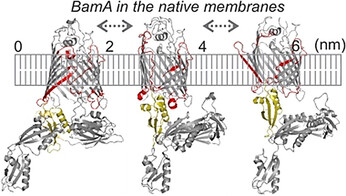
The outer membrane of Gram-negative bacteria is an asymmetric bilayer. The effect of this asymmetry on protein structure and dynamics remains elusive. The β-barrel assembly machinery (BAM) mediates the folding and insertion of proteins into the outer membrane. Using in situ electron spin resonance spectroscopy, we show that the native outer membrane significantly enhances the dynamics of the BamA insertase of the BAM complex.
Two-Dimensional Polymers | Very Important Paper
An Expanded 2D Fused Aromatic Network with 90-Ring Hexagons
- First Published: 08 November 2021
Solar Cells | Hot Paper
Intramolecular Noncovalent Interaction-Enabled Dopant-Free Hole-Transporting Materials for High-Performance Inverted Perovskite Solar Cells
- First Published: 15 November 2021

By incorporating intramolecular S⋅⋅⋅O noncovalent interactions (INIs) for boosting the intrinsic hole mobilities, two simple-structured dopant-free hole-transporting materials (HTMs) were designed and delivered a remarkable efficiency of 21.10 % with decent device stability in inverted perovskite solar cells, demonstrating the great promise of the INI strategy for accessing high-performance dopant-free HTMs.
Supramolecular Chemistry
X⋅⋅⋅X Halogen Bond-Induced Supramolecular Helices
- First Published: 02 November 2021

X⋅⋅⋅X (X=Cl, Br, I) type weak halogen bonds induce the formation of supramolecular helical structures both in solid and solution state. The halogen bonds could further influence the helical nanoarchitectures in mono- and multiple-component coassemblies with melamine, providing a flexible route to prepare chiral functional materials.
Covalent Organic Frameworks | Hot Paper
Tailoring the Pore Surface of 3D Covalent Organic Frameworks via Post-Synthetic Click Chemistry
- First Published: 10 November 2021

A series of highly crystalline 3D COFs with variable loadings of ethynyl groups were designed and synthesized. Remarkably, these alkyne-tagged 3D COFs provide a platform for targeted anchoring various organic groups onto the pore walls via click reactions, which can accordingly change their properties, e.g., the obtained click products exhibited higher CO2/N2 selectivity.
Photomechanical Crystals | Very Important Paper
Correlating Reaction Dynamics and Size Change during the Photomechanical Transformation of 9-Methylanthracene Single Crystals
- First Published: 11 November 2021
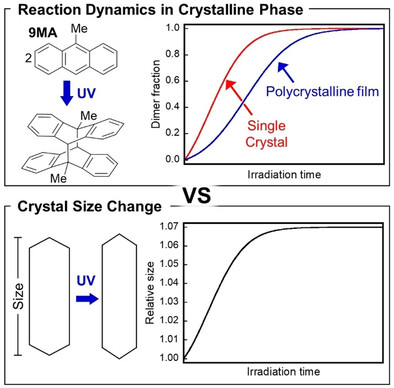
The development of a nonlinear kinetic model for crystal reactions allows us to quantify for the first time how the kinetics depend on sample morphology. Furthermore, the quantitative connection between molecular reaction kinetics and mechanical response in well-defined single crystals provides a new benchmark for analyzing these photomechanical materials.
Metal–Organic Frameworks | Hot Paper
A Metal–Organic Framework as a Multiphoton Excitation Regulator for the Activation of Inert C(sp3)−H Bonds and Oxygen
- First Published: 07 November 2021
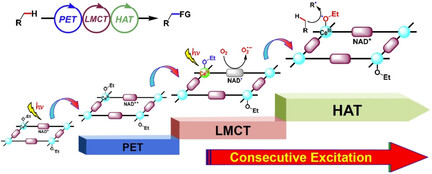
Through covalent modification of the nicotinamide adenine dinucleotide mimics and CeIII-OEt moieties in a metal–organic framework, a new multiphoton excitation approach was developed. This new strategy enables step-by-step triggering of the photoinduced electron transfer, ligand-to-metal charge transfer and hydrogen atom transfer processes for activation of inert C(sp3)−H bonds and oxygen.




